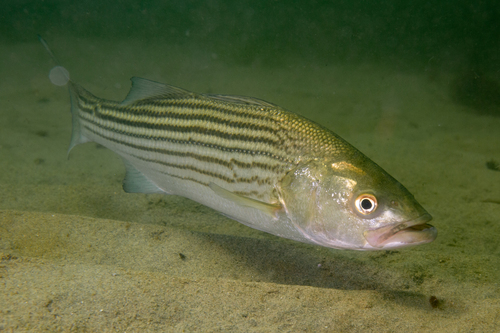
Striped Bass
The Atlantic bluefin tuna (Thunnus thynnus) is a majestic and powerful fish, renowned for its size, speed, and long migrations. This highly sought-after species plays a critical role in the marine ecosystem and holds significant economic importance, particularly in the sushi industry.
5 30 years
Lifespan
120 - 180 cm
Length
Least Concern
Conservation Status
32 km/h
Swimming speed
Carnivorous
Diet
Estuarine Migration, Anadromous
Migration
Appearance Overview
The Atlantic bluefin tuna is a large, torpedo-shaped fish with a streamlined body built for speed and endurance.
Color
Dark metallic blue on top with a silvery underside
Fins
Two dorsal fins, the first depressible; small finlets running down the back and belly
Body shape
Torpedo-shaped, streamlined
Length
up to 13 feet (4 meters)
Weight
up to 2,000 lbs (907 kg)
Diet
Carnivorous, feeding on fish, squid, crustaceans, and eels.
Feeding Behavior
Uses speed and agility to chase down prey, often hunting cooperatively in schools.
Social Behavior
Highly migratory, forming large schools, especially during spawning.
Commercial Relevance
Extremely high value, particularly in sushi and sashimi markets, leading to significant economic importance.
Conservation measures
International fishing quotas, catch limits, and monitoring programs; efforts to reduce bycatch.
Status
Endangered (Varies by population segment; some are recovering due to conservation efforts)
Threats
Overfishing, illegal fishing, habitat degradation, and climate change impacts on prey availability.
Habitat Distribution
Depth Range
0-1,000 meters (typically in the upper layers of the ocean)
Geographic Range
Atlantic Ocean, Mediterranean Sea, and formerly in the Black Sea.
Preferred Environment
Temperate and subtropical waters; open ocean and coastal areas.
Reproduction and Life Cycle
Breeding Habits
Spawns in warm waters, primarily in the Mediterranean Sea and the Gulf of Mexico; spawning is seasonal.
Development Stages
Eggs hatch into larvae; rapid growth in the first year; juveniles mature into adults.
Fecundity
Females can release up to 30 million eggs per spawning season.
Maturity Age
Matures at 4-8 years in the Mediterranean, and around 9 years in the western Atlantic.
Faqs about Striped Bass
How fast can Atlantic bluefin tuna swim?
Atlantic bluefin tuna are among the fastest fish in the ocean, capable of bursts of speed up to 40-60 mph.
How long do Atlantic bluefin tuna live?
They can live up to 40 years, although the average lifespan is closer to 15-25 years.
Is it okay to eat Atlantic bluefin tuna?
Yes, but it is crucial to ensure it comes from a sustainable and well-managed fishery due to overfishing concerns.
How far do Atlantic bluefin tuna migrate?
They undertake long migrations across the Atlantic Ocean, often traveling thousands of miles for feeding and spawning.
How do Atlantic bluefin tuna survive in cold waters?
Their large size, warm-bloodedness (unusual for fish), and specialized muscles allow them to thrive in a wide range of water temperatures.
What makes bluefin tuna so fast?
Their streamlined body shape, powerful muscles, and specialized fins (including finlets) contribute to their incredible speed.
Are bluefin tuna warm-blooded?
Bluefin tuna are warm-blooded, which is rare for fish. This allows them to maintain a higher body temperature than the surrounding water.
Why is bluefin tuna meat red?
The red color comes from high levels of myoglobin, a protein that stores oxygen in their muscles, supporting their active lifestyle.
Can Bluefin Tuna be Farmed?
There has been some success in farming bluefin tuna, but it is challenging and not yet widespread due to their complex life cycle and migratory nature.
Copyright @ Nature Style Limited. All Rights Reserved.
 English
English